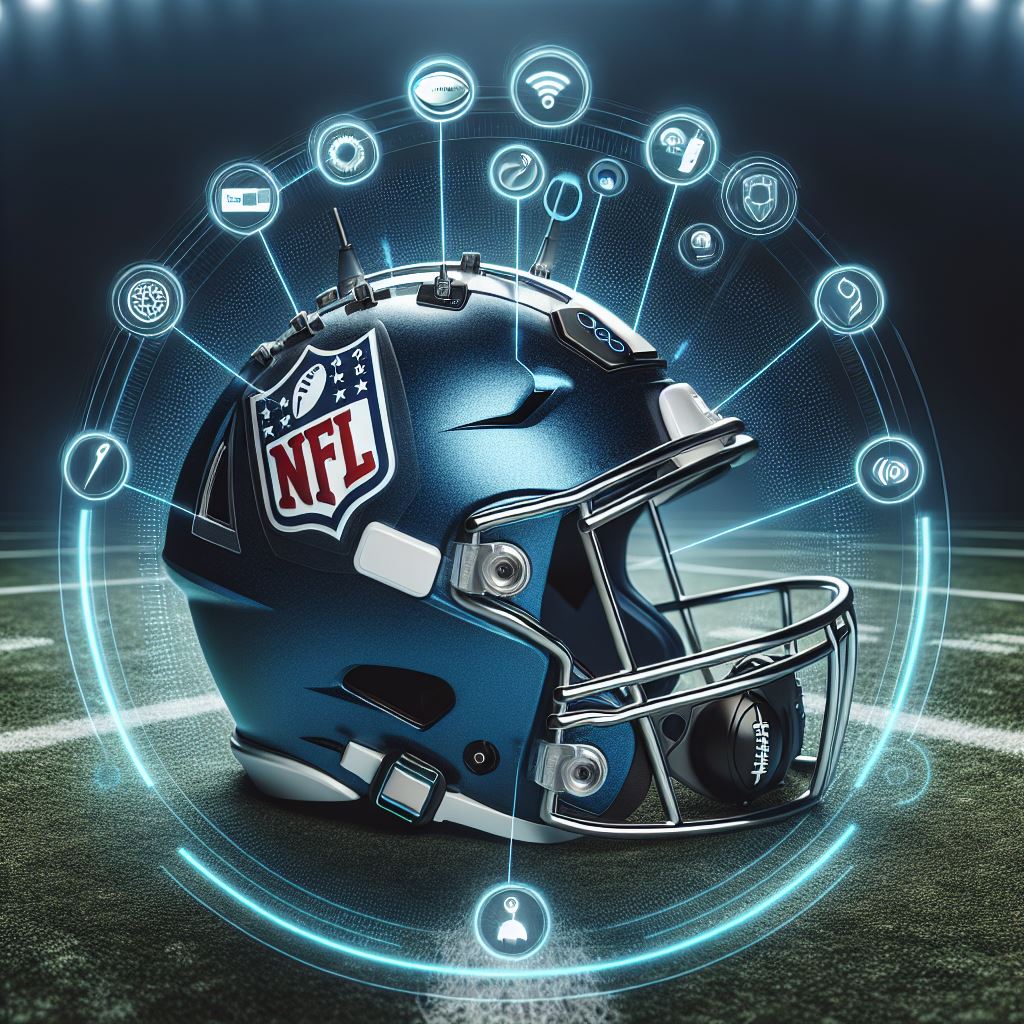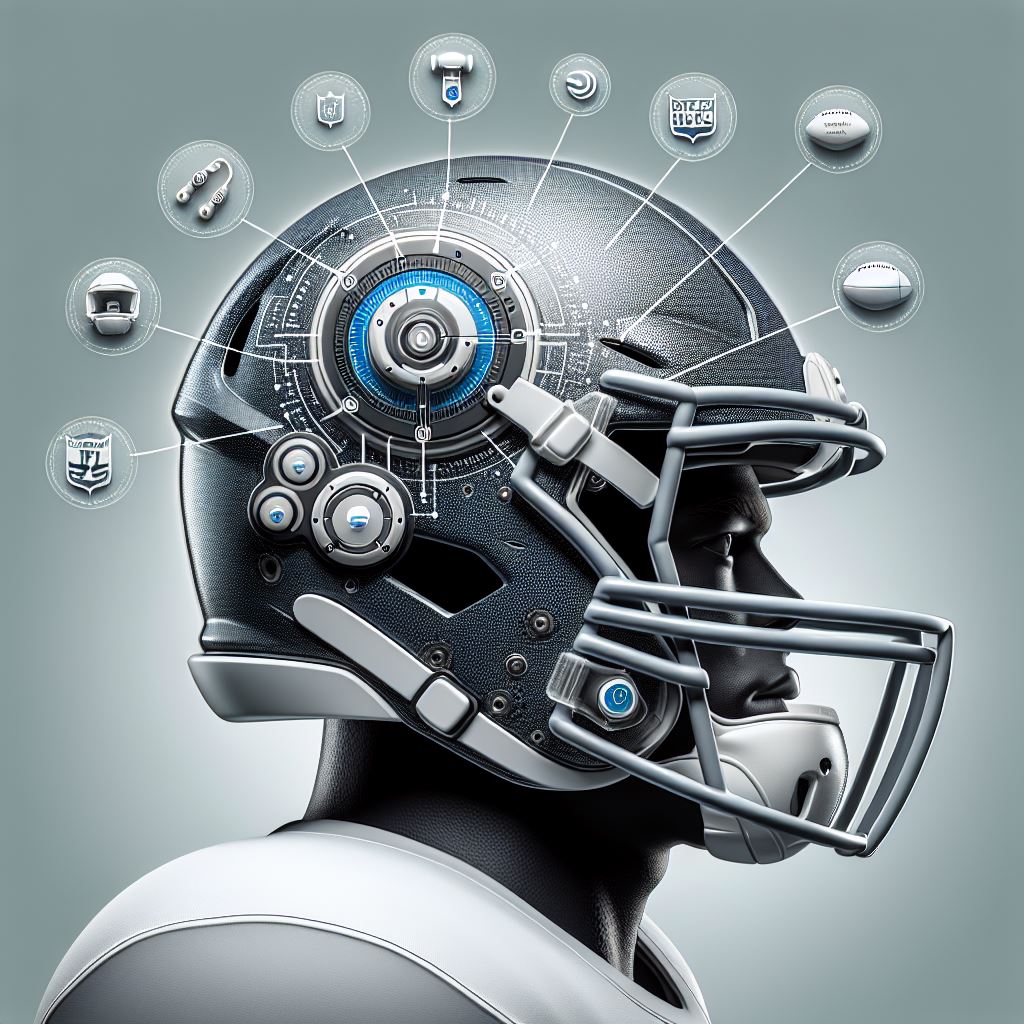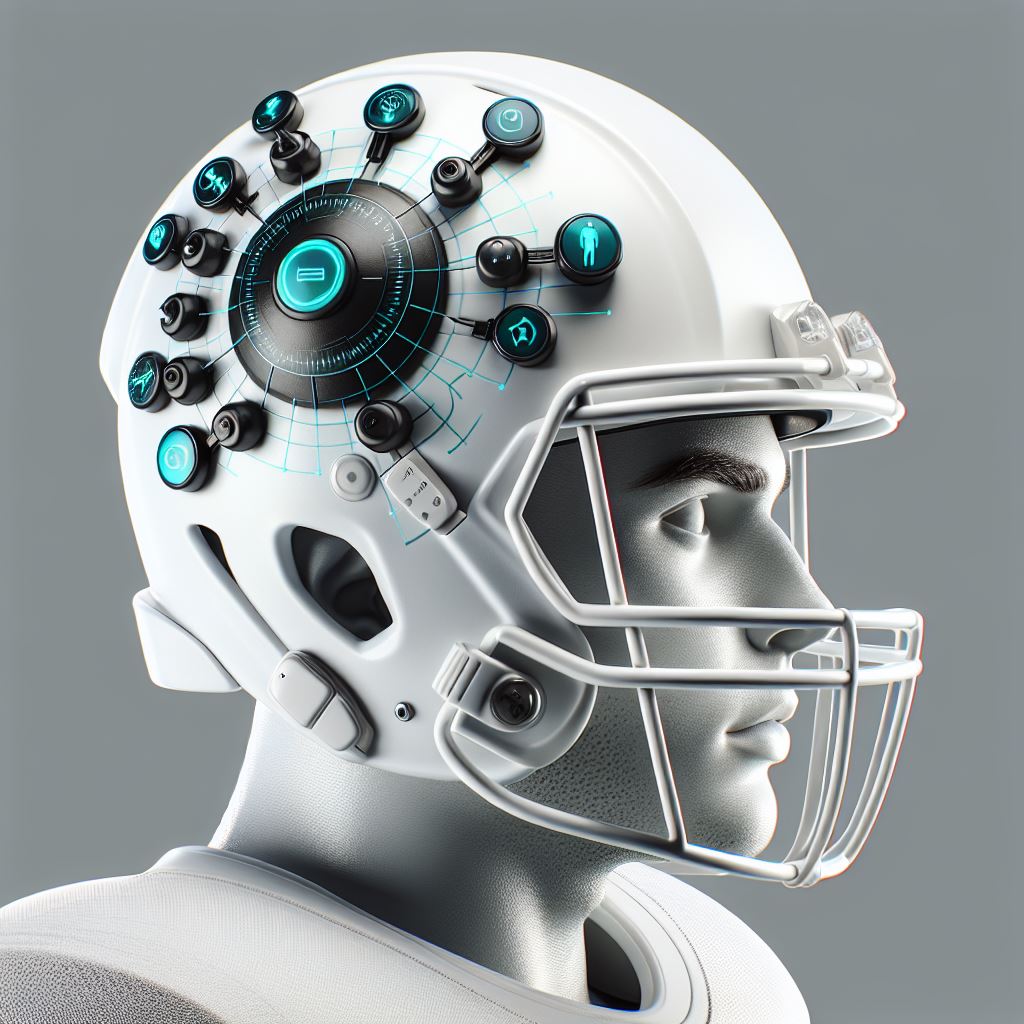Back to Football Tech Main Page
Overview of Helmet Sensors in the NFL
Helmet sensors in the NFL are designed to monitor and collect data on head impacts, helping to improve player safety and performance. These sensors are embedded in players’ helmets and provide real-time data on the forces and directions of impacts. This information is crucial for understanding the dynamics of head injuries and developing better protective equipment.

Applications of Helmet Sensors in Football
More Than Just Gear: How High-Tech Helmet Sensors Are Changing Football Safety
Football is a tough sport, and player safety is a top priority. While helmets have been around for decades, today’s headgear is getting a serious upgrade thanks to cutting-edge technology. Inside many modern football helmets are tiny, powerful sensors that are revolutionizing how we understand and address head impacts.
These sensors aren’t just a gadget; they’re providing invaluable data with crucial applications across player safety, performance analysis, and ongoing research.
Let’s dive into how these helmet sensors are making a real difference:
1. Prioritizing Player Safety
Helmet sensors offer critical tools for protecting players on the field, especially when it comes to head impacts.
- Real-Time Impact Monitoring: Think of it like an early warning system. These sensors provide immediate data on the force and location of impacts a player experiences during a game or practice. If a collision registers as potentially dangerous, medical staff can receive an instant alert, prompting them to quickly assess the player on the sideline for any signs of injury, like a concussion. This immediate intervention is vital for player well-being.
- Proactive Injury Prevention: Beyond reacting to big hits, continuous monitoring helps build a history of impacts for each player. By tracking the frequency and severity of all head impacts over time, medical and coaching staff can identify players who might be accumulating concerning levels of head trauma, even from seemingly minor hits. This data empowers teams to make informed decisions – perhaps adjusting a player’s participation in certain drills, refining their technique to absorb fewer direct impacts, or exploring different protective equipment options to proactively reduce their risk of cumulative head injuries.
2. Enhancing Performance Analysis
The data from helmet sensors isn’t just for medical staff; it’s also a valuable asset for coaches looking to optimize performance while keeping players safe.
- Analyzing Impact Patterns: The detailed data allows analysts to see exactly how and when players are experiencing impacts. Are they consistently taking hits in a certain type of play? Is a specific technique leading to higher impact forces? By recognizing these patterns, coaches can tailor training programs. This might involve teaching players safer blocking or tackling techniques or adjusting play calling to put players in less vulnerable positions, ultimately aiming to enhance on-field effectiveness while minimizing unnecessary risk.
- Driving Equipment Innovation: This impact data is a goldmine for helmet manufacturers. Understanding the real-world forces and angles of impacts helps engineers design better helmets. They can identify areas that need more padding or structural reinforcement, test new materials, and develop helmets that disperse impact energy more effectively. This continuous feedback loop between on-field data and design leads to the development of more advanced, safer protective gear year after year.
3. Fueling Research and Development
The impact data collected by helmet sensors is also a critical resource for the broader scientific and football communities dedicated to making the sport safer.
- Advancing Concussion Research: The detailed information on impact dynamics – how quickly a head accelerates or rotates during a hit – provides scientists with unprecedented data for concussion research. This helps in developing more accurate models of how head injuries occur, improving diagnostic tools, and ultimately leading to better strategies for preventing and treating concussions across all levels of football, from young athletes just starting out to seasoned professionals.
- Integrating Technology for a Fuller Picture: When helmet sensor data is combined with information from other tracking technologies, like GPS that tracks player speed and movement across the field, researchers gain a more complete understanding. They can analyze how factors like speed, collision angles, and player positioning correlate with the severity of impacts. This holistic approach provides deeper insights, helping to develop more comprehensive safety measures and refine coaching strategies for both performance and protection.

Challenges and Future Developments of Helmet Sensors
The Next Frontier: Tackling the Challenges and Shaping the Future of Football Helmet Sensors
While helmet sensors are already powerful tools for enhancing safety and analysis in football, the technology isn’t standing still. Like any advanced system, there are challenges researchers and engineers are actively working to overcome, paving the way for even more sophisticated solutions in the future.
Understanding these challenges and the exciting developments underway helps us see the full potential of this technology.
Here are the key hurdles and what’s next for football helmet sensors:
1. Achieving Ultimate Accuracy and Precision
Getting consistently perfect data from sensors inside a helmet during the chaotic environment of a football game is tougher than it sounds.
-
The Accuracy Challenge: Think about everything happening on the field – players are running, jumping, colliding, and helmets are shifting. Factors like exactly how snug the helmet fits, subtle player movements, and the complex physics of impacts (is it a direct hit, a glancing blow, a rotational force?) can all affect the data the sensors collect. Sometimes, these variables can lead to slight inconsistencies or make it tricky to get a perfectly precise reading of every single impact. Plus, making sure the tiny sensors stay in the optimal position inside the helmet throughout a game is an ongoing engineering task.
-
The Future is Sharper Data: The good news is that the drive for more reliable data is leading to significant advancements. We’re seeing the development of more sensitive and sophisticated sensor technology, including highly advanced accelerometers (measuring changes in speed) and gyroscopes (measuring rotation). These next-generation sensors are designed to capture impact dynamics with greater fidelity. Simultaneously, researchers are developing improved data analysis techniques that utilize the power of machine learning and artificial intelligence. These smart algorithms can better interpret the raw sensor data, filtering out noise and more accurately assessing the severity and type of impact a player experienced, leading to more trustworthy insights for safety and performance.
2. Seamlessly Integrating Data for Deeper Insights
A single data source is good, but combining information from multiple technologies unlocks a much richer understanding of what’s happening on the field.
- The Data Integration Challenge: Helmet sensors provide crucial information about impacts to the head. But to fully understand the context of that impact – how fast was the player running? What direction were they moving? Where were other players on the field? – you need data from other systems like GPS trackers (for speed and position) and potentially other player or ball tracking technologies (like RFID). Bringing all these different streams of data together in a synchronized and meaningful way is a significant technical challenge.
- The Future is Connected Understanding: The push is towards multi-source data integration. By building systems that can seamlessly combine helmet sensor data with information from GPS, player tracking, and even video analysis, teams and researchers can gain a truly comprehensive view. This allows for enhanced contextual analysis, revealing how specific movements, speeds, or game situations correlate with different types of impacts. This holistic data picture is invaluable for identifying risk factors and refining strategies. Furthermore, this integrated data feeds into advanced analytics platforms. Using sophisticated machine learning models, researchers can uncover subtle patterns and trends in impact data that might not be visible from a single source. This opens the door for developing predictive models that could potentially identify players at a higher risk of certain injuries based on their unique impact history and playing style. The ultimate goal of this enhanced integration and analytics is to provide real-time, actionable feedback to medical staff and coaches, enabling them to make immediate, data-informed decisions during the game when dangerous impacts occur.
Helmet sensors have revolutionized the way player safety and performance are monitored in the NFL. By providing real-time data on head impacts, these sensors help identify potentially dangerous situations and ensure timely medical evaluations. The data collected is also used to improve helmet design and develop better protective equipment, enhancing player safety and performance over time. As technology continues to advance, the future of helmet sensors in the NFL promises even more innovative applications and improvements in player safety and performance.



